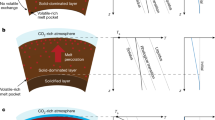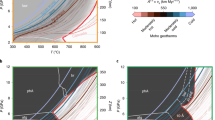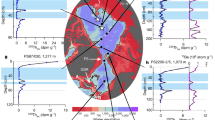Abstract
Given the scarcity of geological data, knowledge of Earth’s landscape during the Archaean eon is limited. Although the continental crust may have been as massive as present by 4 Gyr ago, the extent to which it was submerged or exposed is unclear. One key component in understanding the amount of exposed landmasses in the early Earth is the evolution of the oceanic lithosphere. Whereas the present-day oceanic lithosphere subsides as it ages, based on numerical models of mantle convection we find that higher internal heating due to a larger concentration of radioactive isotopes in the Archaean mantle halted subsidence, possibly inducing seafloor shallowing before 2.5 Gyr ago. In such a scenario, exposed landmasses in the form of volcanic islands and resurfaced seamounts or oceanic plateaus can remain subaerial for extended periods of time, and may have provided the only stable patches of dryland in the Archaean. Our results therefore permit a re-evaluation of possible locations for the origin of life, as they provide support to an existing hypothesis that suggests that life had its origins on land rather than in an oceanic environment.
This is a preview of subscription content, access via your institution
Access options
Access Nature and 54 other Nature Portfolio journals
Get Nature+, our best-value online-access subscription
$29.99 / 30 days
cancel any time
Subscribe to this journal
Receive 12 print issues and online access
$259.00 per year
only $21.58 per issue
Buy this article
- Purchase on Springer Link
- Instant access to full article PDF
Prices may be subject to local taxes which are calculated during checkout




Similar content being viewed by others
Data availability
Data used for figures in the main text and Methods are generated by our convection and freeboard computer codes. We have been unable to share these data due to the substantial size of the data files. Computer code to generate data files, however, is available upon request to the corresponding authors.
Code availability
Computer code is available upon request to the corresponding authors.
References
Miller, S. L. A production of amino acids under possible primitive Earth conditions. Science 117, 528–529 (1953).
Lazcano, A. & Bada, J. L. The 1953 Stanley L. Miller experiment: fifty years of prebiotic organic chemistry. Orig. Life Evol. Biosph. 33, 235–242 (2003).
Bada, J. L. New insights into prebiotic chemistry from Stanley Miller’s spark discharge experiments. Chem. Soc. Rev. 42, 2186–2196 (2013).
Chyba, C. & Sagan, C. Endogenous production, exogenous delivery and impact-shock synthesis of organic molecules: an inventory for the origins of life. Nature 355, 125–132 (1992).
Miller, S. L. & Bada, J. L. Submarine hot springs and the origin of life. Nature 334, 609–611 (1988).
Mulkidjanian, A. Y., Bychkov, A. Y., Dibrova, D. V., Galperin, M. Y. & Koonin, E. V. Origin of first cells at terrestrial, anoxic geothermal fields. Proc. Natl Acad. Sci. USA 109, E821–E830 (2012).
Ranjan, S., Todd, Z. R., Rimmer, P. B., Sasselov, D. D. & Babbin, A. R. Nitrogen oxide concentrations in natural waters on early Earth. Geochem. Geophys. Geosyst. 20, 2021–2039 (2019).
Martin, W., Baross, J., Kelley, D. & Russell, M. J. Hydrothermal vents and the origin of life. Nat. Rev. Microbiol. 6, 805–814 (2008).
Peretó, J., Bada, J. L. & Lazcano, A. Charles Darwin and the origin of life. Orig. Life Evol. Biosph. 39, 395–406 (2009).
Weiss, M. et al. The physiology and habitat of the last universal common ancestor. Nat. Microbiol. 1, 16116 (2016).
Sleep, N. H. Geological and geochemical constraints on the origin and evolution of life. Astrobiology 18, 1199–1219 (2018).
Benner, S. A., Kim, H. J. & Carrigan, M. A. Asphalt, water, and the prebiotic synthesis of ribose, ribonucleosides, and RNA. Acc. Chem. Res. 45, 2025–2034 (2012).
Mutschler, H., Wochner, A. & Holliger, P. Freeze–thaw cycles as drivers of complex ribozyme assembly. Nat. Chem. 7, 502–508 (2015).
Damer, B. A field trip to the Archaean in search of Darwin’s warm little pond. Life 6, 21 (2016).
Benner, S. A., Kim, H. J., Kim, M. J. & Ricardo, A. Planetary organic chemistry and the origins of biomolecules. Cold Spring Harb. Perspect. Biol. 2, a003467 (2010).
Bada, J. L. & Korenaga, J. Exposed areas above sea level on Earth >3.5Gyr ago: implications for prebiotic and primitive biotic chemistry. Life 8, 55 (2018).
Pearce, B. K. D., Pudritz, R. E., Semenov, D. A. & Henning, T. K. Origin of the RNA world: the fate of nucleobases in warm little ponds. Proc. Natl Acad. Sci. USA 114, 11327–11332 (2017).
Rosas, J. C. & Korenaga, J. Rapid crustal growth and efficient crustal recycling in the early Earth: implications for Hadean and Archean geodynamics. Earth Planet. Sci. Lett. 494, 42–49 (2018).
Guo, M. & Korenaga, J. Argon constraints on the early growth of felsic continental crust. Sci. Adv. 6, 21 (2020).
Korenaga, J., Planavsky, N. J. & Evans, D. A. D. Global water cycle and the coevolution of the Earth’s interior and surface environment. Philos. Trans. R. Soc. A 375, 20150393 (2017).
Turcotte, D. L. & Schubert, G. Geodynamics (Cambridge Univ. Press, 2002).
Parsons, B. & McKenzie, D. Mantle convection and the thermal structure of the plates. J. Geophys. Res. 83, 4485–4496 (1978).
Sleep, N. H. Small-scale convection beneath oceans and continents. Chi. Sci. Bull. 56, 1292–1317 (2011).
Korenaga, J. Pitfalls in modeling mantle convection with internal heat production. J. Geophys. Res. 122, 4064–4085 (2017).
Korenaga, J. & Jordan, T. H. Physics of multiscale convection in Earth’s mantle: onset of sublithospheric convection. J. Geophys. Res. 108, 2333 (2003).
Korenaga, J. in The Interdisciplinary Earth: A Volume in Honor of Don L. Anderson (eds Gillian, F. R. et al.) 167–185 (Geological Society of America, 2015).
Hager, B. in Glacial Isostasy, Sea Level and Mantle Rheology (eds Sabadini, R. et al.) 493–513 (American Geophysical Union, 1991).
Korenaga, J. Initiation and evolution of plate tectonics on Earth: theories and observations. Annu. Rev. Earth Planet. Sci. 41, 117–151 (2013).
Herzberg, C., Condie, K. & Korenaga, J. Thermal history of the Earth and its petrological expression. Earth Planet. Sci. Lett. 292, 79–88 (2010).
Korenaga, J. in Archean Geodynamics and Environments (eds Benn, K. et al.) 7–32 (American Geophysical Union, 2006).
Korenaga, T. & Korenaga, J. Evolution of young oceanic lithosphere and the meaning of seafloor subsidence rate. J. Geophys. Res. 121, 6315–6332 (2016).
Servali, A. & Korenaga, J. Oceanic origin of continental mantle lithosphere. Geology 46, 1047–1050 (2018).
Bindeman, I. N. et al. Rapid emergence of subaerial landmasses and onset of a modern hydrologic cycle 2.5 billion years ago. Nature 557, 545–548 (2018).
Ito, E., Harris, D. M. & Anderson, A. T. Alteration of oceanic crust and geologic cycling of chlorine and water. Geochim. Cosmochim. Acta 47, 1613–1624 (1983).
Jarrard, R. D. Subduction fluxes of water, carbon dioxide, chlorine, and potassium. Geochem. Geophys. Geosyst. 4, 8905 (2003).
Bradley, D. C. Passive margins through Earth history. Earth Sci. Rev. 91, 1–26 (2008).
Condie, K., Pisarevsky, S. A., Korenaga, J. & Gardoll, S. Is the rate of supercontinent assembly changing with time? Precambrian Res. 259, 278–289 (2015).
Pehrsson, S. J., Eglington, B. M., Evans, D. A. D., Huston, D. & Reddy, S. M. in Supercontinent Cycles Through Earth History (eds Li, Z. X. et al.) 83–94 (Geological Society of London, 2016).
Magni, V., Bouilhol, P. & van Hunen, J. Deep water recycling through time. Geochem. Geophys. Geosyst. 15, 4203–4216 (2014).
van Keken, P. E., Hacker, B. R., Syracuse, E. M. & Abers, G. A. Subduction factory: 4. Depth-dependent flux of H2O from subducting slabs worldwide. J. Geophys. Res. 116, B1 (2011).
Stein, C. A. & Stein, S. A model for the global variation in oceanic depth and heat flow with lithospheric age. Nature 359, 123–129 (1992).
Korenaga, J. Crustal evolution and mantle dynamics through Earth history. Philos. Trans. R Soc. A 376, 20170408 (2018).
Walter, M. R., Buick, R. & Dunlop, J. S. R. Stromatolites 3,400–3,500 Myr old from the North Pole area, Western Australia. Nature 284, 443–445 (1980).
Bell, E. A., Boehnke, P., Harrison, T. M. & Mao, W. L. Potentially biogenic carbon preserved in a 4.1 billion-year-old zircon. Proc. Natl Acad. Sci. USA 112, 14518–14521 (2015).
Rey, P. F. & Houseman, G. Lithospheric scale gravitational flow: the impact of body forces on orogenic processes from Archaean to Phanerozoic. Geol. Soc. Lond. Spec. Publ. 253, 153–167 (2006).
Deamer, D. W. & Georgiou, C. D. Hydrothermal conditions and the origin of cellular life. Astrobiology 15, 1091–1095 (2015).
Burcar, B. T. et al. RNA oligomerization in laboratory analogues of alkaline hydrothermal vent systems. Astrobiology 15, 509–522 (2015).
Baaske, P. et al. Extreme accumulation of nucleotides in simulated hydrothermal pore systems. Proc. Natl Acad. Sci. USA 104, 9346–9351 (2007).
Solomatov, V. S. & Moresi, L. N. Scaling of time-dependent stagnant lid convection: application to small-scale convection on Earth and other terrestrial planets. J. Geophys. Res. 105, 21795–21817 (2000).
Karato, S. & Wu, P. Rheology of the upper mantle: a synthesis. Science 260, 771–778 (1993).
Acknowledgements
We are grateful to K. Rogers, L. Williams and R. Hernandez for their help and assistance while preparing this manuscript. This material is based upon work supported in part by two grants from the US National Aeronautics and Space Administration: (1) through the NASA Astrobiology Institute under Cooperative Agreement No. NNA15BB03A, and (2) under Cooperative Agreement No. 80NSSC19M0069, both issued through the Science Mission Directorate. This material is also supported by the US National Science Foundation under grant EAR-1753916.
Author information
Authors and Affiliations
Contributions
J.C.R. performed the calculations and wrote the manuscript. J.K. designed the project, discussed the results and commented on the manuscript.
Corresponding authors
Ethics declarations
Competing interests
The authors declare no competing interests.
Additional information
Peer review information Nature Geoscience thanks Norman Sleep and the other, anonymous, reviewer(s) for their contribution to the peer review of this work. Primary Handling Editor: Rebecca Neely.
Publisher’s note Springer Nature remains neutral with regard to jurisdictional claims in published maps and institutional affiliations.
Extended data
Extended Data Fig. 1 Modelling strategy.
Numerical results of a model with Ra = 3 × 109 (η0 ≈ 1.3 × 1019 Pa s) and H* = 13.2 (H = 2.12 × 10−12 W kg−1), appropriate for present-day Earth. a-b: Snapshots of uppermost section of temperature field 40 Ma and 109 Ma, before and after onset of convection, respectively, with temperature contours at an interval of 100∘ C. c: Horizontally averaged temperature profiles for snapshots a and b. d: Ridge-perpendicular thermal structure constructed by assembling horizontally averaged temperature profiles for every time step. Subsidence may then be calculated by computing instantaneous Stokes flow and applying Equation (1). Location of temperature profiles a and b, as well as the onset time, are shown. Isotherms of 1200∘ C and 1300∘ C as calculated using radiogenic heating (RH; solid) and half space cooling (HSC; dashed) bathymetries are highlighted. before onset time, thermal structure of radiogenic heating model resembles that predicted by HSC model.
Extended Data Fig. 2 Subsidence deviation.
a: Evolution of δw for models with different values of H* and Ra = 3 × 108. Models are divided into conductive and convective phases at onset time, with each phase being fitted by a linear trend (δw1 and δw2, respectively). For any H*, δw1 intersects the horizontal axis at \({t}_{i}^{1/2}=2.5\) Myr1/2. b-c: Slope of δw1 (b) and δw2 at \({t}_{\max }=500\) Myr (c) as a function of H*. Linear trends are given by m1 = a1H* in b, where a1 = 0.001, and by \(\delta {w}_{2}({t}_{\max })={a}_{2}{H}^{* }+{b}_{2}\) in c, where a2 = 0.0228 and b2 = 0.0452. Colour coding as in a.
Extended Data Fig. 3 Comparison between modelled bathymetry and empirical scaling law.
a-c: Modelled seafloor subsidence for models with Ra = 3 × 108 (a), Ra = 1 × 109 (b) and Ra = 3 × 109 (c), respectively (solid). Colour coding as in Extended Data Figure 2. Seafloor subsidence as predicted from empirical scaling law is also shown (equation 16; dashed). d-f: Difference between modelled seafloor subsidence and empirical scaling for Ra = 3 × 108 (d), Ra = 1 × 109 (e) and Ra = 3 × 109 (f), respectively. Colour coding as in a. Zero-difference level is shown (thin horizontal line). Difference never exceeds 250 m (dashed horizontal lines).
Rights and permissions
About this article
Cite this article
Rosas, J.C., Korenaga, J. Archaean seafloors shallowed with age due to radiogenic heating in the mantle. Nat. Geosci. 14, 51–56 (2021). https://doi.org/10.1038/s41561-020-00673-1
Received:
Accepted:
Published:
Issue Date:
DOI: https://doi.org/10.1038/s41561-020-00673-1
This article is cited by
-
Magnesium silicate chimneys at the Strytan hydrothermal field, Iceland, as analogues for prebiotic chemistry at alkaline submarine hydrothermal vents on the early Earth
Progress in Earth and Planetary Science (2024)
-
Liquid and supercritical CO2 as an organic solvent in Hadean seafloor hydrothermal systems: implications for prebiotic chemical evolution
Progress in Earth and Planetary Science (2022)
-
Diverse geochemical conditions for prebiotic chemistry in shallow-sea alkaline hydrothermal vents
Nature Geoscience (2022)
-
Marine phosphate availability and the chemical origins of life on Earth
Nature Communications (2022)



